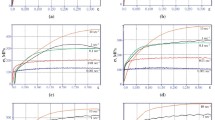Conclusions
-
1.
The approaches of nonequilibrium thermodynamics allow us to formulate a new criterion for optimizing the choice of the temperature and rate of plastic deformation for structural steels and alloys. This is the fraction η of the energy supplie to the material which is spent for accommodation adjustments of the material in the process plastic deformation.
-
2.
By plotting three-dimensional diagrams and contour maps of constant values of η in the coordinates\(\dot \varepsilon - t\), we can localize the temperature and rate ranges of maximum values of η.
-
3.
A study of the structure and phase composition has shown that the maxima of the efficiency of energy dissipation usually correspond to the simultaneous occurrence of accommodation processes such as dynamic recrystallization, grain-boundary slip, and phase recrystallization.
-
4.
The use of the new criterion makes it possible to create a simple and effective algorithm for choosing optimum tempeature and rate regimes for plastic deformation of structural materials.
Similar content being viewed by others
References
M. L. Bernshtein (ed.),Diagrams of Hot Deformation. Structure and Properties of Steels, Handbook [in Russian], Metallurgiya, Moscow (1989).
S. I. Bulach, A. S. Tikhonov, and A. K. Dubrovin,Deformability of Structurally Nonuniform Steels and Alloys [in Russian], Metallugriya, Moscow (1995).
Y. V. R. K. Prasad, H. L. Gegel, S. M. Doratvelu, et al.,Met. Trans. A,15, 1883 (1984).
V. V. Rybin,High Plastic Deformation and Fracture of Metals [in Russian], Metallurgiya, Moscow (1986).
A. A. Zisman and V. V. Rybin, “On the effect of internal stresses on the resitance of crystalline bodies to plastic deformation”,Fiz. Met. Metalloved.,69 (4), 5–14 (1990).
O. A. Kaibyshev,Superplasticity of Commercial Alloys [in Russian], Metallurgiya, Moscow (1984).
Additional information
Translated from Metallovedenie i Termicheskaya Obrabotka Metallov, No. 9, pp. 52–56, September, 1999.
Rights and permissions
About this article
Cite this article
Vargasov, N.R., Rybin, V.V. Optimization of temperature and rate regimes of plastic deformation by the criterion of dissipation of mechanical energy. Met Sci Heat Treat 41, 417–421 (1999). https://doi.org/10.1007/BF02469882
Issue Date:
DOI: https://doi.org/10.1007/BF02469882




